By Lambert Strether of Corrente.
Patient readers, matters occurent prevented me from delivering the encyclopedic post on The People of The State of New York -against- Donald J. Trump, Defendant, that I had researched for, though I suppose I’ll get another bite at the Big Rotten Apple soon enough. Monday was the first day of Trump’s trial in Manhattan, which began amongst small crowds. The session was devoted to jury selection, although none were actually selected (“more than half of the 96 jurors called Monday said they couldn’t be ‘fair and impartial’ when it comes to the former president“). For me, the most dramatic event was Trump falling asleep, albeit briefly, which could actually be strategically brilliant: Trump should talk to voters — and do his all-important A/B testing! — via Zoom at night, and then sleep in court during the day! He could bring a pillow from that pillow guy. That would also keep him out of trouble! (Also, Trump said Judge Merchan denied his request to attend his son’s graduation, when what Merchan actually did was postpone a decision. Judge Merchan also said Trump would have to be in court next week, meaning he won’t be present when the Supreme Court hears arguments about his claims to Presidential immunity.)
So this post will of necessity be short and simple: I will examine at the odd structure of Bragg’s case. There’s a lot more to be said, but that is all I have time for today. Oh, and my routine caveat: IANAL. I hope any real lawyers will step in and correct any errors, expand on this analysis, share their experience, strength, and hope….. Oh. Sorry. Wrong meeting.
First, the structure. From the Manhattan District Attorney’s press release, “District Attorney Bragg Announces 34-Count Felony Indictment of Former President Donald J. Trump“:
Manhattan District Attorney Alvin L. Bragg, Jr. today announced the indictment of DONALD J. TRUMP, 76, for falsifying New York business records in order to conceal damaging information and unlawful activity from American voters before and after the 2016 election. During the election, TRUMP and others employed a “catch and kill” scheme to identify, purchase, and bury negative information about him and boost his electoral prospects. TRUMP then went to great lengths to hide this conduct, causing dozens of false entries in business records to conceal criminal activity, including attempts to violate state and federal election laws.
The difficulty that Bragg’s press release glosses over is that the “catch and kill” scheme is not illegal. Falsifying business records is illegal, but it’s a misdemeanor except when committed in furtherance of another crime, when it becomes a felony (or, in this case, 34 felonies; Bragg pumped up the numbers, just as Smith did with his sekrit documents). So what is this other crime? Amazingly, Bragg does not say.[1] IANAL, but to my simple mind, “odd” is a fair word for this approach.
Bragg’s filing, says the Press Release, comprises two documents: The Indictment, and the Statement of Facts.
The 34 counts of the Indictment all look alike. Here is the 34th:
As you can see, the count is a felony (“First Degree”) under Penal Law §175.10. Again, what makes it a felony? That the false entry was made with the intent to commit “another crime.” But that crime is mentioned nowhere in the Indictment.
Now let’s turn to the Statement of Facts. First, let me quote footnote 1 (of 1):
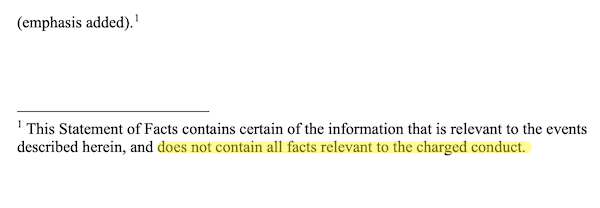
So we have an Indictment whose degree (first/felony or second/misdemeanor) depends on unspecified “other crimes,” and we have a Statement of Facts that doesn’t contain all the facts relevant to the charges in the Indictment. Wouldn’t it have been simpler for Bragg to hand the court a ream of blank paper and say “We’ll fill this in as we go along?” Again, IANAL, but I think “odd” is a fair word.
The rest of the Statement of Facts is a laudably painstaking account of document flow within the Trump organization, and as a former documents maven I cannot forbear from quoting:
The checks and stubs bearing the false statements were stapled to the invoices also bearing false statements. The Defendant signed each of the checks personally and had them sent back to the Trump Organization in New York County. There, the checks, the stubs, and the invoices were scanned and maintained in the Trump Organization’s data system before the checks themselves were detached and mailed to Lawyer A for payment.
Sterling stuff, but the key aspect of the Statement of Facts occurs in the first two paragraphs (though oft-repeated):
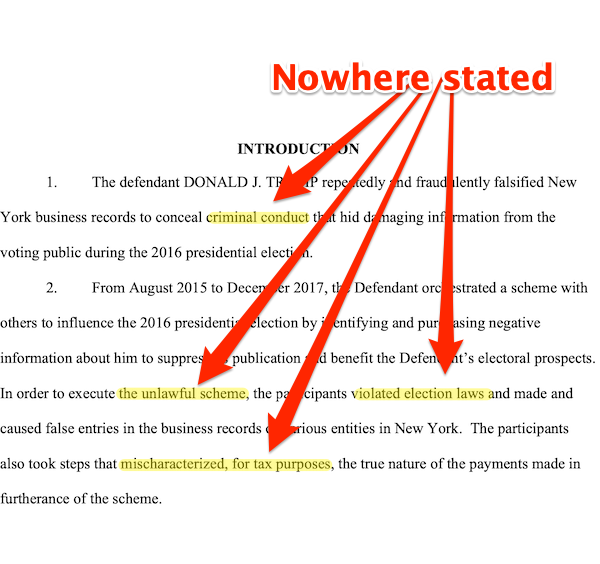
“Criminal conduct” that breaks what law? Unstated in the Statement of Facts, and uncharged in the Indictment. The same is true for “unlawful scheme,” “violated election laws”, and “mischaracterized for tax purposes.” How are these “facts” as opposed to assertions or unsupported claims? Trump must either have been convicted of these crimes already, or be charged with them now. If the former, the case should be cited. If the latter, the charge should appear in the Indictment. Neither is true. Isn’t that odd?
Naturally, the Trump Defense team asked District Attorney Bragg about all this, in particular the “other crime”:
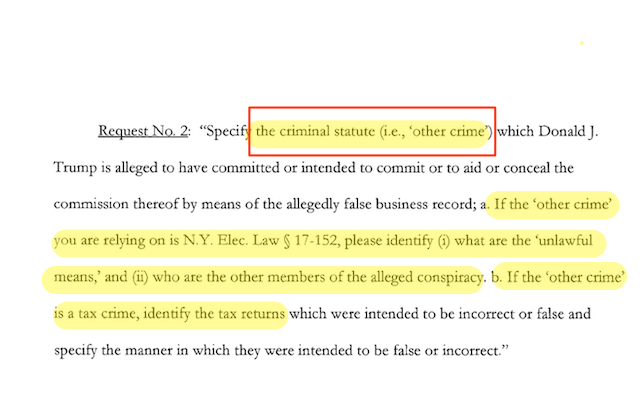
Here in relevant part is Bragg’s response, which I have helpfully annotated:
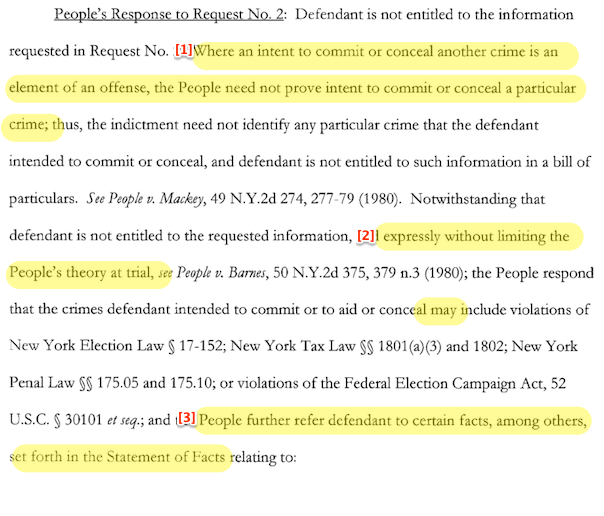
[1] Will Franz Kafka please pick up the white courtesy phone?
[2] Oh, so there’s no theory of the case in the Indictment or the Statement of Facts?
[3] No. Just no. You can’t refer the Defense to a fact to prove a charge. That’s your job as prosecutor.
Law360’s Frank Runyeon summarized what these “other crimes” “may” be in plain English:
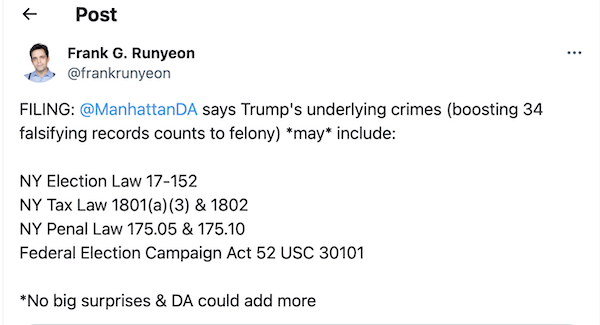
There’s a lot of discussion of the merits of charging Trump with these hypothetical “other crimes,” and I’m sure I’ll have plenty to say about Trump’s putative other crimes when Bragg reveals what the other crimes actually are. For now, my layperson’s view is that having a state enforce a Federal Law (in this case, the Federal Election Campaign Act) is nuts. Do we want states enforcing, say, the Espionage Act? Really? Presumably there’s a dividing line of some sort. Where?
Finally, here’s a handy diagram that shows the structure of Bragg’s case, via Asha Rangappa (former FBI Special Agent and editor of Just Security). I have added some helpful annotations:
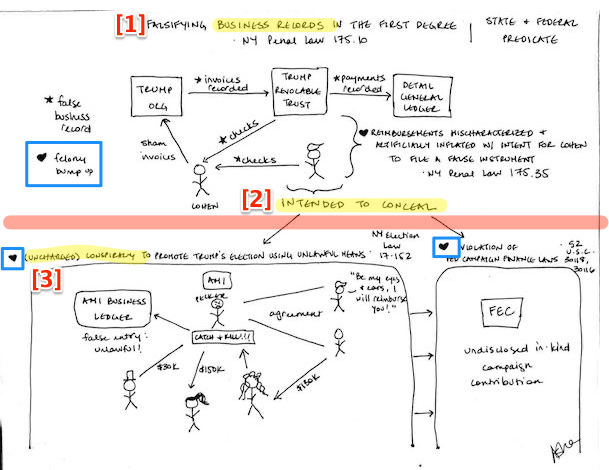
[1] The top half of the diagram is the business records case, showing the document flows described in the Statement of Facts.
[2] The bottom half of the diagram is the “other crimes” that convert what would be misdemeanors into felonies. (Rangappa amusingly labels this process, marked in blue, a “felony bump-up.”) You will observe that to reduce the felonies down to misdemeanors, the Trump defense team must delink the records charges above the red line from the “other crimes” below. This will be more manageable, of course, when Bragg reveals what they are.
[3] The highlighted text implies that the “other crime” could be an “(uncharged) conspiracy.” That seems odd, too, not to say Kafka-esque. The “other crime” can be a crime that Trump was only convicted of on some alternate timeline? IANAL, so can this possibly be true?
It will be interesting to see what the Indictment and the Facts actually are, when Bragg chooses to reveal them. Again, I hope any real lawyers will jump in with their views; I am, after all, merely a humble blogger, and what I view as nuts may be perfectly normal and routine.
NOTES
[1] I have not seen anyone assert that there’s anything wrong with Bragg’s procedure here, but how is the defense supposed to prepare to defend their client against the crime that transforms misdemeanors into felonies if they are not told what that crime is?


